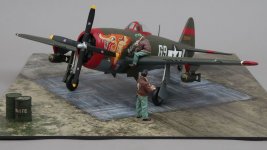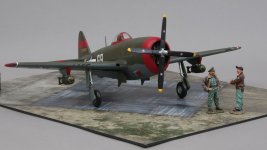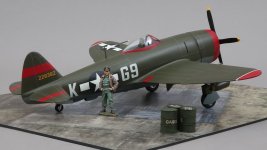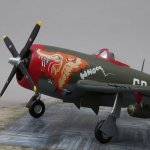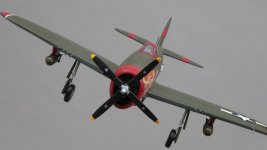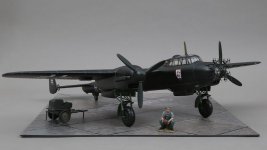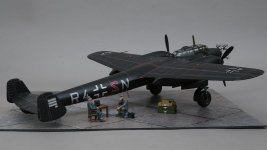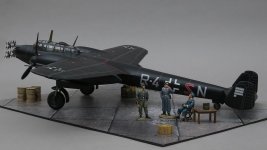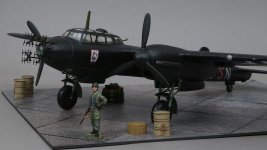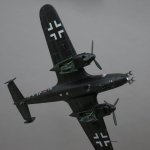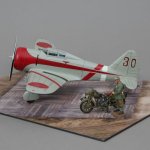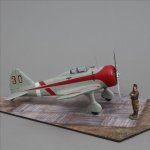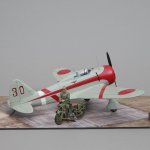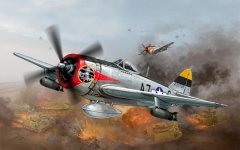Gunn Miniatures
Command Sergeant Major
- Joined
- Jun 18, 2009
- Messages
- 2,728
WOW485 Junkers Ju.287 Jet Bomber
The Ju 287 was intended to provide the Luftwaffe with a bomber that could avoid interception by outrunning enemy fighters. The swept-forward wing was suggested by the project's head designer Dr. Hans Wocke as a way of providing extra lift at low airspeeds - necessary because of the poor responsiveness of early turbojet engines, at the vulnerable times of takeoff and landing. A further structural advantage of the forward-swept wing was that it would allow for a single massive bomb bay in the best location, the centre of gravity of the plane, with the main wing spar passing behind the bomb bay. The same structural requirement meant the wing could then be located at the best aerodynamic location, the centre of the fuselage. The Junkers 287 was one of the only jet aircraft ever designed with a fixed undercarriage, this concept was used as the wing box couldn't have cutouts for wheel stowage, which would reduce wing torsion box stiffness required for the forward sweep design. Later prototypes with higher power engines and higher top speed would have the undercarriage stowage in the centre fuselage sides.
Flight tests began on 16 August 1944 (pilot: Siegfried Holzbaur), with the aircraft displaying extremely good handling characteristics, as well as revealing some of the problems of the forward-swept wing under flight conditions. The most notable of these drawbacks was 'wing warping', or excessive in-flight flexing of the main spar and wing assembly. Tests suggested that the warping problem would be eliminated by concentrating greater engine mass under the wings. This technical improvement would be incorporated in the subsequent prototypes with under wing engines moved forward under leading edge as a mass balance. Several versions were underway during 1944, the final Ju 287 variant design to be mooted was a Mistel combination-plane ground attack version, comprising an unmanned explosives-packed "drone" 287 and a manned Me 262 fighter attached to the top of the bomber by a strut assembly. The cockpit of the 287 would be replaced by a massive impact-fused warhead. Takeoff and flight control of the combination would be under the direction of the 262's pilot. The 262 would disengage from the 287 drone as the Mistel neared its target, the pilot of the fighter remotely steering the 287 for the terminal phase of its strike mission.
Work on the Ju 287 programme, along with all other pending German bomber projects came to a halt in July 1944,the site was overrun by the Soviets in 1945 with the staff being sent to Russia for an extended vacation, most never returned.
This 1/30 scale model is priced at $1200 plus shipping, we have a total of 3 available. The figures and accessories are shown for scale comparison purposes only.
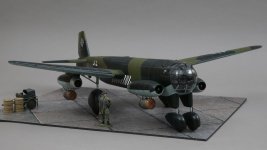
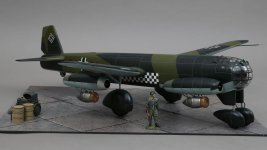
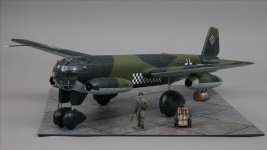
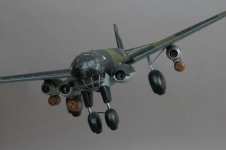
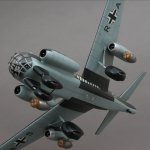
That's all for this month, we sincerely hope you enjoy the pictures and would love to hear from you if any of these magnificent models appeal to you. They are all now on our website www.tomgunn.co.uk and can be paid for upfront or over an extended monthly period.
All Gunn Club members qualify for a 5% discount on the website listed price, joining is free so well worth registering.
Reference our latest figure release, SS135A Officer Pointing has sold out, the winter German 'Breakfast Club' have also reached the low stock status and so have the ROM160/167 B/C versions with only a few sets left ins tock.
Best wishes The Gunn Team
The Ju 287 was intended to provide the Luftwaffe with a bomber that could avoid interception by outrunning enemy fighters. The swept-forward wing was suggested by the project's head designer Dr. Hans Wocke as a way of providing extra lift at low airspeeds - necessary because of the poor responsiveness of early turbojet engines, at the vulnerable times of takeoff and landing. A further structural advantage of the forward-swept wing was that it would allow for a single massive bomb bay in the best location, the centre of gravity of the plane, with the main wing spar passing behind the bomb bay. The same structural requirement meant the wing could then be located at the best aerodynamic location, the centre of the fuselage. The Junkers 287 was one of the only jet aircraft ever designed with a fixed undercarriage, this concept was used as the wing box couldn't have cutouts for wheel stowage, which would reduce wing torsion box stiffness required for the forward sweep design. Later prototypes with higher power engines and higher top speed would have the undercarriage stowage in the centre fuselage sides.
Flight tests began on 16 August 1944 (pilot: Siegfried Holzbaur), with the aircraft displaying extremely good handling characteristics, as well as revealing some of the problems of the forward-swept wing under flight conditions. The most notable of these drawbacks was 'wing warping', or excessive in-flight flexing of the main spar and wing assembly. Tests suggested that the warping problem would be eliminated by concentrating greater engine mass under the wings. This technical improvement would be incorporated in the subsequent prototypes with under wing engines moved forward under leading edge as a mass balance. Several versions were underway during 1944, the final Ju 287 variant design to be mooted was a Mistel combination-plane ground attack version, comprising an unmanned explosives-packed "drone" 287 and a manned Me 262 fighter attached to the top of the bomber by a strut assembly. The cockpit of the 287 would be replaced by a massive impact-fused warhead. Takeoff and flight control of the combination would be under the direction of the 262's pilot. The 262 would disengage from the 287 drone as the Mistel neared its target, the pilot of the fighter remotely steering the 287 for the terminal phase of its strike mission.
Work on the Ju 287 programme, along with all other pending German bomber projects came to a halt in July 1944,the site was overrun by the Soviets in 1945 with the staff being sent to Russia for an extended vacation, most never returned.
This 1/30 scale model is priced at $1200 plus shipping, we have a total of 3 available. The figures and accessories are shown for scale comparison purposes only.





That's all for this month, we sincerely hope you enjoy the pictures and would love to hear from you if any of these magnificent models appeal to you. They are all now on our website www.tomgunn.co.uk and can be paid for upfront or over an extended monthly period.
All Gunn Club members qualify for a 5% discount on the website listed price, joining is free so well worth registering.
Reference our latest figure release, SS135A Officer Pointing has sold out, the winter German 'Breakfast Club' have also reached the low stock status and so have the ROM160/167 B/C versions with only a few sets left ins tock.
Best wishes The Gunn Team


